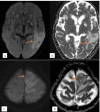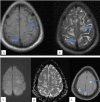Role of Multiparametric Magnetic Resonance Imaging of the Brain in Differentiating Neurocysticercosis From Tuberculoma
- PMID: 37323306
- PMCID: PMC10263174
- DOI: 10.7759/cureus.39003
Role of Multiparametric Magnetic Resonance Imaging of the Brain in Differentiating Neurocysticercosis From Tuberculoma
Abstract
Introduction: The two most common infectious causes of ring-enhancing lesions are neurocysticercosis (NCC) and tuberculoma. It is a challenge to differentiate NCC and tuberculomas radiologically since they show the same imaging findings on computed tomography (CT). Hence, this study was performed to assess the role of magnetic resonance imaging (MRI) as an additional advanced modality to aptly characterize the lesion. Conventional MRI with additional advanced imaging sequences like diffusion-weighted imaging (DWI), apparent diffusion coefficient (ADC), magnetic resonance spectroscopy (MRS), and post-contrast T1-weighted imaging (T1WI) aids in characterizing the lesion and helps in differentiating NCC and tuberculomas.
Objectives: To compare the findings of DWI, ADC cut-off values, spectroscopy, and contrast-enhanced MRI in differentiating NCC from tuberculoma.
Materials and methods: Individuals who matched the inclusion criterion underwent an MRI of the brain (plain and contrast) in a 1.5 Tesla, 18-channel, magnetic resonance scanner (Magnetom Avanto®, Siemens Healthineers, Erlangen, Germany). The following imaging sequences were included: T1WI (axial and sagittal), T2-weighted imaging (axial and coronal), fluid-attenuated inversion recovery, DWI at 0, 500, and 1000 mm2/s b-values with corresponding ADC values, and single-voxel MRS. Based on MRI features such as number, size, location, margins of lesions, scolex, surrounding edema, DWI features with corresponding ADC values, enhancement pattern of lesions, and spectroscopy findings, we evaluated and differentiated the lesions as NCC or tuberculoma. Radiological diagnoses were correlated in terms of clinical symptoms and response to treatment.
Results: In our study, 42 subjects were included, of which the total number of NCC cases was 25 (59.52%) and tuberculoma was 17 (40.47%). The mean age of patients included was 42.85 ± 14.76 years (21 to 78 years). On post-contrast imaging, all 25 cases of NCC (100%) showed thin ring enhancement whereas the majority of tuberculomas (64.7%) showed thick irregular ring enhancement. On MRS, all 25 cases (100%) of NCC showed an amino acid peak and all 17 cases (100%) of tuberculoma showed a lipid lactate peak. On DWI, out of 25 NCC cases, restriction of diffusion was absent in the majority of cases (88%) and out of 17 cases of tuberculoma, restriction of diffusion was present in 12 cases (70.5%) (T2 hyperintense tuberculoma, indicative of caseating tuberculoma with central liquefaction) and was absent in the rest. In our study, the mean ADC value of NCC lesions (1.30 ± 0.137 x 10-3 mm2/s) was found to be greater than that of tuberculoma (0.74 ± 0.090 x 10-3 mm2/s). ADC value of 1.2 x 10-3 was obtained as a cut-off to differentiate NCC and tuberculoma. The ADC cut-off value of 1.2 x 10-3 mm2/s showed a sensitivity of 92% and specificity of 94.1% in differentiating NCC from tuberculoma.
Conclusions: Conventional MRI with additional advanced imaging sequences like DWI, ADC, MRS, and post-contrast T1WI aids in characterizing the lesion and thereby helps in differentiating NCC and tuberculomas. Hence, multiparametric MRI assessment is useful in making a prompt diagnosis and eliminating the need for a biopsy.
Keywords: adc values; apparent diffusion coefficient; diffusion-weighted imaging; magnetic resonance spectroscopy; neurocysticercosis; tuberculoma.
Copyright © 2023, Joy et al.
Conflict of interest statement
The authors have declared that no competing interests exist.
Figures










Similar articles
-
Role of MRI in Differentiating Various Posterior Cranial Fossa Space-Occupying Lesions Using Sensitivity and Specificity: A Prospective Study.Cureus. 2021 Jul 12;13(7):e16336. doi: 10.7759/cureus.16336. eCollection 2021 Jul. Cureus. 2021. PMID: 34395119 Free PMC article.
-
Multiparametric magnetic resonance imaging features of giant intracranial tuberculomas.Clin Neurol Neurosurg. 2021 Nov;210:107006. doi: 10.1016/j.clineuro.2021.107006. Epub 2021 Oct 25. Clin Neurol Neurosurg. 2021. PMID: 34739879
-
Evaluation of intracranial tuberculomas using diffusion-weighted imaging (DWI), magnetic resonance spectroscopy (MRS) and susceptibility weighted imaging (SWI).Br J Radiol. 2018 Nov;91(1091):20180342. doi: 10.1259/bjr.20180342. Epub 2018 Jul 23. Br J Radiol. 2018. PMID: 29987985 Free PMC article.
-
Non-Contrast MRI Sequences for Ischemic Stroke: A Concise Overview for Clinical Radiologists.Vasc Health Risk Manag. 2024 Nov 26;20:521-531. doi: 10.2147/VHRM.S474143. eCollection 2024. Vasc Health Risk Manag. 2024. PMID: 39618686 Free PMC article. Review.
-
State of the art in the diagnostic evaluation of osteomyelitis: exploring the role of advanced MRI sequences-a narrative review.Quant Imaging Med Surg. 2024 Jan 3;14(1):1070-1085. doi: 10.21037/qims-23-1138. Epub 2024 Jan 2. Quant Imaging Med Surg. 2024. PMID: 38223108 Free PMC article. Review.
Cited by
-
Cerebral Neuroschistosomiasis Presenting as a Brain Mass.Cureus. 2023 Sep 17;15(9):e45418. doi: 10.7759/cureus.45418. eCollection 2023 Sep. Cureus. 2023. PMID: 37854757 Free PMC article.
-
Neurocysticercosis: unwinding the radiological conundrum.Pol J Radiol. 2024 Nov 28;89:e549-e560. doi: 10.5114/pjr/193968. eCollection 2024. Pol J Radiol. 2024. PMID: 39777324 Free PMC article.
-
Intracranial tuberculomas diagnosed with Xpert MTB/RIF Ultra assay of formalin-fixed paraffin-embedded brain tissues and treated with an optimized antituberculosis regimen: A case report.Heliyon. 2024 Jun 5;10(11):e32462. doi: 10.1016/j.heliyon.2024.e32462. eCollection 2024 Jun 15. Heliyon. 2024. PMID: 38961962 Free PMC article.
References
-
- Revised set of diagnostic criteria for neurocysticercosis (in reply to Garg and Malhotra) Del Brutto OH, Nash TE, White AC Jr, et al. J Neurol Sci. 2017;373:350–351. - PubMed
-
- Tuberculoma versus neurocysticercosis: can magnetic resonance spectroscopy and diffusion weighted imaging solve the diagnostic conundrum? Maheshwarappa RP, Agrawal C, Bansal J. J Clin Diagn Res. 2019;13:0–6.
-
- Differentiating between solitary ring enhancing neurocysticerosis and tuberculoma: prospective cross sectional study in adult population. Singh J, Khalid S, Chaurasia K. Asian J Med Res. 2019;8:1–4.
LinkOut - more resources
Full Text Sources
